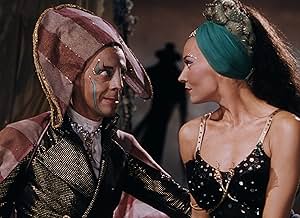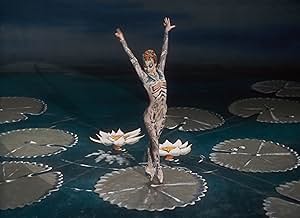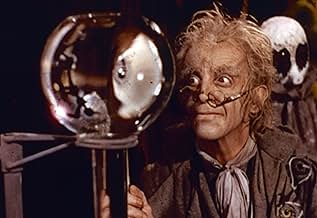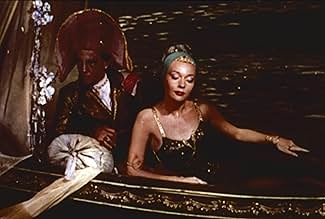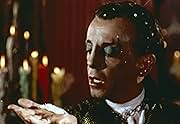Un poeta malinconico riflette su tre donne che ha amato e perso in passato: una bambola meccanica, una cortigiana veneziana e la figlia di un celebre compositore.Un poeta malinconico riflette su tre donne che ha amato e perso in passato: una bambola meccanica, una cortigiana veneziana e la figlia di un celebre compositore.Un poeta malinconico riflette su tre donne che ha amato e perso in passato: una bambola meccanica, una cortigiana veneziana e la figlia di un celebre compositore.
- Regia
- Sceneggiatura
- Star
- Candidato a 2 Oscar
- 2 vittorie e 3 candidature totali
- Giulietta
- (as Ludmilla Tcherina)
- …
- Spalanzani
- (as Leonide Massine)
- …
- Olympia
- (voce (canto))
- …
- Giulietta
- (voce (canto))
- …
- Nicklaus
- (voce (canto))
- …
- Antonia's Mother
- (voce (canto))
- Spalanzani
- (voce (canto))
- …
Recensioni in evidenza
But the drawback is that only the tale of Olympia, the mechanical doll, and the ill-fated love affair with the young Hoffmann (played in all three segments by tenor Robert Rounseville) is up to the top standards the film strives to achieve. The other tales of Hoffmann's follies are less interesting, not as easy to understand and not as entertaining or melodious as the Olympia segment.
The final tale of Antonia suffers from the high notes forced upon screeching soprano (Anne Ayars) and the demands of the score which is clearly more tedious than melodious at this point.
Robert Helpmann as the villain in all three tales is excellent and Robert Rounseville as Hoffmann is the only cast member who does his own singing in a strong tenor voice. You may remember him as Mr. Snow in Rodgers and Hammerstein's "Carousel" with Gordon MacRae and Shirley Jones.
But there's no denying the magic of all the visual images on screen which includes the use of puppets and a good mixture of cinema and stage techniques. Opera lovers will find fault with some of the singers but it's hard to see any fault in the dancing which looked magnificent to me.
None of the stories are as involving as "The Red Shoes" and this is one of the weaknesses of the film. The first story is far better than the rest of the tales which makes for an uneven blend of storytelling.
A brilliant use of color and classical music makes it a "must see" for most film buffs.
However, unlike THE RED SHOES, HOFMMAN is a much colder experience. For a film about the joys and sufferings of love and desire, the whole thing is quite remote, never reaching the emotional depth of other Powell and Pressburger films. The whole thing feels overlong and if you aren't an opera fan, you aren't likely to take to the music either.
The three sequences which make up the runtime are uneven: the Olympia story is whimsical and fun though a touch overlong; the Giuletta sequence is gothic and well-paced; the Antonia sequence is just about the worst. Olympia and Giuletta benefit from having charismatic performers at their center in Moira Shearer and Ludmilla Tcherina, but Ann Ayars lacks any real personality as the dying songstress, making the last section such a drag to sit through.
By the time the film came to its close, I was more than ready for it to be done with. No doubt, a lot went into the sets, costumes, special effects, and camera work. I must also give a shout-out to Robert Rounseville as Hoffman: he carries himself well throughout the long running time. But I'm sorry to be the naysayer: when a movie is over two hours long, I need more than gorgeous visuals to see me through it.
The story begins in Nuremberg as Hoffmann watches the object of his affections, Stella (Moira Shearer) dance a ballet. During the intermission, he goes into a tavern and tells the customers about his three major affairs.
Opera singers, with two exceptions, dub the stars, who are mostly from the ballet world; several will be familiar from The Red Shoes: Moira Shearer, Ludmilla Tcherina, Robert Helpmann, Léonide Massine, and Frederick Ashton. Only Hoffmann, Robert Rounsville, and Antonia, Anne Ayars, do their own singing. The rest of the vocals are provided by Dorothy Bond, Margherita Grandi, Monica Sinclair, Joan Alexander, Grahame Clifford, Bruce Dargavel, Murray Dickie, Owen Brannigan, Fisher Morgan, and Rene Soames.
Both the singing and dancing are absolutely magnificent, the beautiful Shearer dancing much better than she did in The Red Shoes several years earlier, and Powell and Pressburger fill the opera with fantastic effects and colors. My favorite is Shearer's doll ballet sequence, with the glorious coloratura singing of the Doll Aria by Dorothy Bond, a discovery of Sir Thomas Beecham, who conducts the orchestra. Tragically she was killed in a car accident the next year; she deserved to be one of the most famous sopranos who ever lived.
There are a couple of problems with this incredible piece. It's done in English, which due to the tamber of the high soprano voice, can make it difficult to understand. So people who know the opera would probably enjoy it the most. Secondly, it's not paced very well - there are some very draggy sections; some of the chorus work could have been cut.
The overall effect for the eyes and ears is fabulous, but "The Tales of Hoffmann" leaves one depressed for how far we've fallen culturally in this world. Imagine mounting this film today. How many people would attend? Five?
Lo sapevi?
- QuizGeorge A. Romero, writer/director of La notte dei morti viventi (1968) and Zombi (1978) has cited this as his all-time favorite movie, saying that it was the one that originally inspired him to get into filmmaking.
- BlooperGiulietta's necklace is turned from jewels to wax by Dapertutto, however, in a longer shot, it is briefly shown as jewels again, before a close-up, where it is wax again until Dapertutto changes it back to jewels.
- Citazioni
Chorus of Students: Some drink, drink, drink, drink, drink: do you hear us about? You lazy lout! We want some beer; we want some wine! Pour out the wine, and drink and drink till morning. Pour out the wine for drinking is divine. It is divine. We want some beer; we want some wine. We want some beer; we want some wine.
- Curiosità sui creditiIn the end credits, main actors appear taking curtain calls next to the singers who dubbed them.
- Versioni alternativeThe complete 138-minute version was available in 16mm black and white early television prints. The complete 138-minute version was also available in 16mm Kodachrome (color) rental prints. The complete 138-minute soundtrack was available for many years on LP (London Records).
- ConnessioniFeatured in The Late Show: Michael Powell (1992)
- Colonne sonoreThe Tales of Hoffmann, A Fantastic Opera
Music by Jacques Offenbach
Arranged by Thomas Beecham (uncredited)
English libretto by Dennis Arundell
From the French text by Jules Barbier
Conductor: Thomas Beecham (as Sir Thomas Beecham Bart.) with The Royal Philharmonic Orchestra
Sung by Robert Rounseville, Dorothy Bond, Margherita Grandi, Ann Ayars (as Ann Ayars), Monica Sinclair, Joan Alexander, Grahame Clifford, Bruce Dargavel, Murray Dickie, Owen Brannigan, Fisher Morgan, Rene Soames, and The Sadler's Wells Chorus
I più visti
Dettagli
- Data di uscita
- Paese di origine
- Lingua
- Celebre anche come
- Los cuentos de Hoffman
- Luoghi delle riprese
- Aziende produttrici
- Vedi altri crediti dell’azienda su IMDbPro
Botteghino
- Lordo Stati Uniti e Canada
- 91.930 USD
- Fine settimana di apertura Stati Uniti e Canada
- 23.340 USD
- 15 mar 2015
- Lordo in tutto il mondo
- 140.714 USD
- Tempo di esecuzione2 ore 13 minuti
- Proporzioni
- 1.37 : 1
Contribuisci a questa pagina




